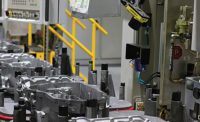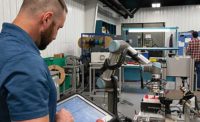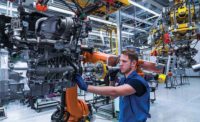When preproduction of the next-generation Tempest fighter jet ramps up next year, assemblers at BAE Systems will be using cutting-edge technology. The goal is to improve plant floor productivity while reducing the traditional time and cost associated with aircraft manufacturing.
BAE recently invested in state-of-the-art Industry 4.0 tools to equip its smart factory in Warton, England. The company believes that applying digital tools, such as additive manufacturing, augmented reality, automated guided vehicles, collaborative robots, data analytics and smart workstations, will revolutionize combat aircraft production.
“Bringing together advanced manufacturing technologies, the factory will transform engineering processes,” says Dave Holmes, manufacturing director at BAE Systems Air. “[It] will increase speed, precision and efficiencies, as well as reduce the costs associated with the manufacture of complex military aircraft structures.
“The factory also demonstrates a new approach to the way humans and machines can operate together,” claims Holmes. “[Collaborative] and flexible robotic technologies remove the need for heavy, fixed, long-lead tooling and can quickly switch from the manufacture of one item or platform to another.
“Intelligent machines and off-the-shelf robotic technology from the automotive industry have been modified to operate at the precise tolerances required for military aircraft, which are less than a third the width of a human hair on some of our programs,” explains Holmes.
“Such technology drives greater productivity by allowing operators to focus on more highly skilled and strategic tasks, [while enabling] production managers to oversee operations from a fully digitized, virtual office,” Holmes points out.
“Our ambition is to drive down the cost of manufacturing through improved efficiencies and the increased use of automation,” adds Andy Schofield, director of manufacturing and materials technology at BAE Systems. “The UK government set an ambitious vision for [domestic] industry to deliver a future combat air system by 2035, which means that we must look to deliver such a capability in half the time of previous programs.
“By continuing to embrace the latest in digital capability, and doing this in a smart, collaborative way, we can remove cost and time from the manufacturing process,” claims Schofield. “Our aim is an agnostic, reconfigurable assembly configuration.
“Where traditionally an aircraft would move from one station to the next in each stage of the manufacturing process, our focus is to build an adaptable and agile operating system,” explains Schofield. “One that, because of the increased use of digital and automated technology, will allow us to switch from one aircraft program or operation to another, without the need for [things such as] heavy, long-lead jig structures.
“This will allow us to produce low volumes effectively and adapt easily to the scale and scope of our customers’ requirements,” Schofield points out.
“Our Factory of the Future initiative is a test bed for optimizing operational processes ranging from detail manufacturing to assembly through to aircraft maintenance,” says Schofield. “[For instance], we recently introduced an intelligent workstation on our Typhoon production line.”
The workstation was developed in collaboration with Fairfield Control Systems Ltd. (FCS) and the Advanced Manufacturing Research Centre at the University of Sheffield. It uses a vision system that recognizes operators and automatically delivers tailored work instructions using pick-by-light technology.
According to Schofield, the goal of the collaborative workbench is to:
- Reduce the learning curves associated with product change.
- Allow information to be consumed in a modern manner.
- Accommodate a more transient workforce and support operations with greater flexibility.
- Create standard processes and put greater emphasis on the manufacturing engineering content produced.
Engineers at FCS designed a workbench that enables assemblers to adjust height and lighting levels to suit their personal preferences. These settings can be saved and then reloaded using RFID identity cards that automatically adjust the workstation when logging on.
“This adjustment greatly increases ergonomics and comfort for user who are required to stand, orientate and work on a varied range of parts,” says Oliver Mangham, applications director at FCS. “These parts are generally complex in shape, come in many different sizes and comprise numerous components.”
Once logged on, operators receive work instructions that are issued from BAE Systems’ SAP system. These operations include step-by-step assembly tasks.
As operators move through the instructions, an optical projection system highlights specific areas of the task that are being referred to. An automatic vision system is also used periodically to verify that work instructions have been completed correctly before moving on to the next assembly task.





